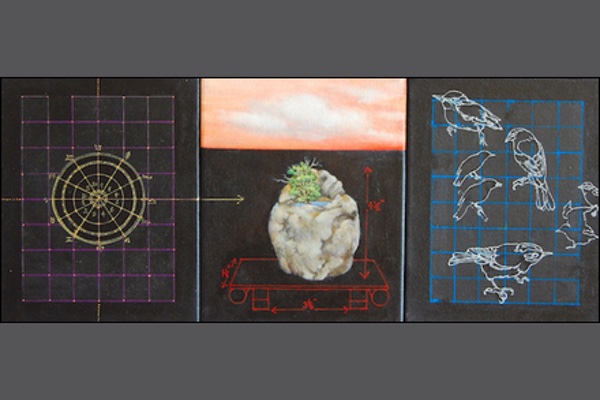“…the results only appear in the imagination.”
By Jean Eng

My cat has been stalking me. I decided to stalk her back—with a sketchbook. Nothing distracts potential ambush like a black book and drawing implement whipped out in front of her face. I furiously scribble impressions of feline interruptus curioso before she twitches again. It’s been a while since I resumed the sketchbook. My work involves mainly thumbnail drawings—and then it’s straight to canvas with occasional stops to transfer images from tracing paper. With the reinstatement of the sketchbook, came the faculty of “eye-drawing.”
Eye-drawing has become my secret pleasure. I do it at work, on the subway, in restaurants, or walking down the street. Blame it on the cat, but the looking and seeing required to draw anything again, has spilled out into the world; refreshed my vision. Eye-drawing is performed without art tools or supplies; yet an artist still needs to be present with what they observe. It’s an exercise where everyone is viewed as a possible drawing, but the results only appear in the imagination. To prevent this from turning into a prurient activity, I regard all who captivate my interest with respectful appreciation. This actually isn’t hard, provided I take casual, neutral glances and don’t stare.
During art school, attractive models were always a challenge to draw because I found them least interesting. It was harder to glean human essence overlaid by the glamour of good looks. With eye-drawing, I became once again, more intrigued by prominent noses, girth, set mouths etc. The fictional Conté crayon described what animated the physicality of a person much better when they had unusual or outstanding characteristics. Often I just focused on body parts: hands (my favourite), profiles, torso views. These were easier to do because lengthy observation was less noticeable. Stop lights choreographed one-minute gestures from pedestrians waiting for signal changes. Bank tellers, cashiers, service attendants offered longer poses. Bus routes and the passengers within, transformed into a cornucopia of models in extended positions. I used up whole sticks of phantom charcoal on Toronto Transit alone.
Then things got weird. Sometimes I mentally x-rayed others through their clothes, to discern structural anatomy underneath, and drew from there. The strangeness had nothing to do with an “I see naked people” kind of thing. I began to feel towards my subjects, a mixture of tenderness and melancholy. By “stripping people down,” I exposed myself to their humanity in mass proportions. I saw a television show once, about a character who developed the superpower to hear everyone’s thoughts. She was overwhelmed not just by the noise, but also the revelation of so much longing, anguish and fear. My experience felt similar except on a visual level. I understand now why life-drawing sessions need to be contained by the structure and intent of a learning or studio environment. What the hand interprets from visual perception, as well as time limits set for poses, regulates how much information is processed in a given period.
It’s a good system; I appreciate it more than ever. Haven’t suspended eye-drawing completely though; just cut back. Whenever a tidal sense of over-identification with the humanity in front of me threatens to engulf, I pause from tracing the figure in my mind. Instead, I gently think: there goes another work of art.
Originally published on http://engjarticles.blogspot.com.

